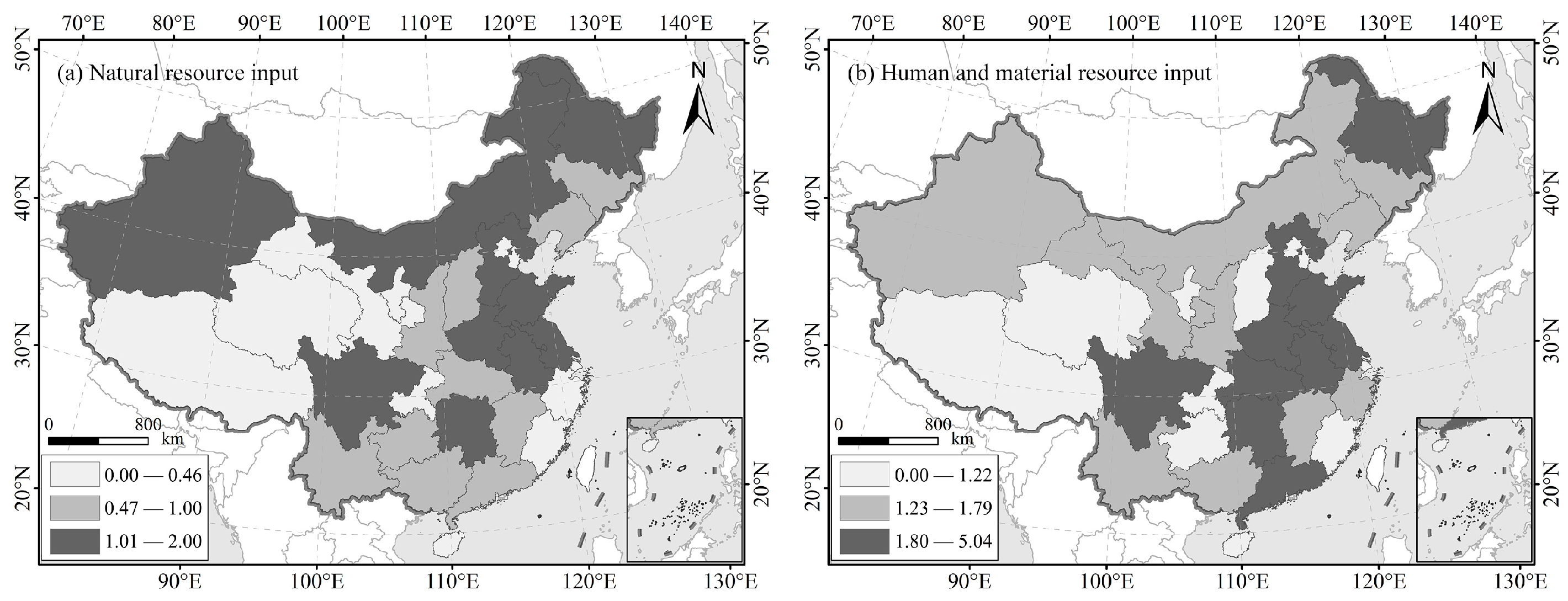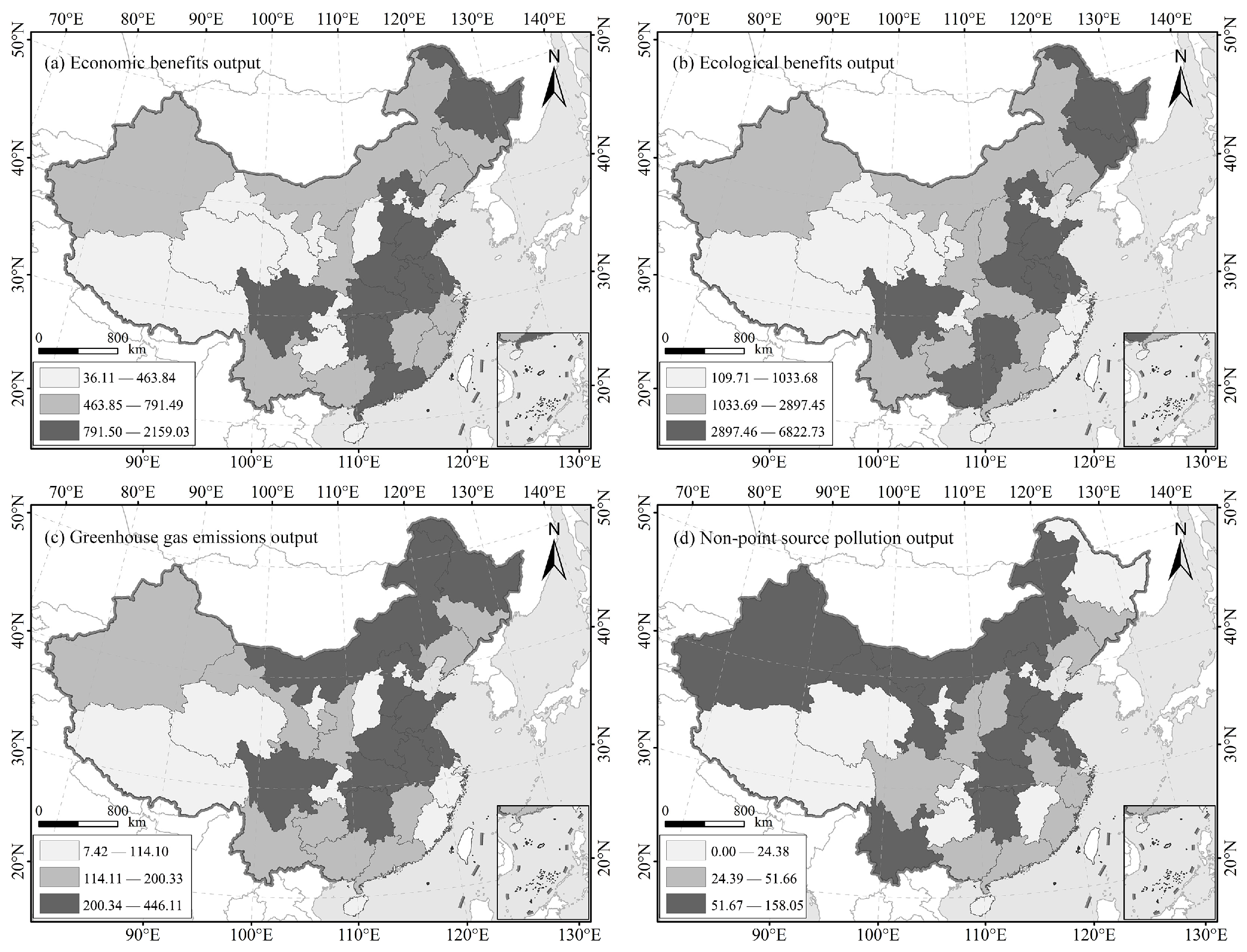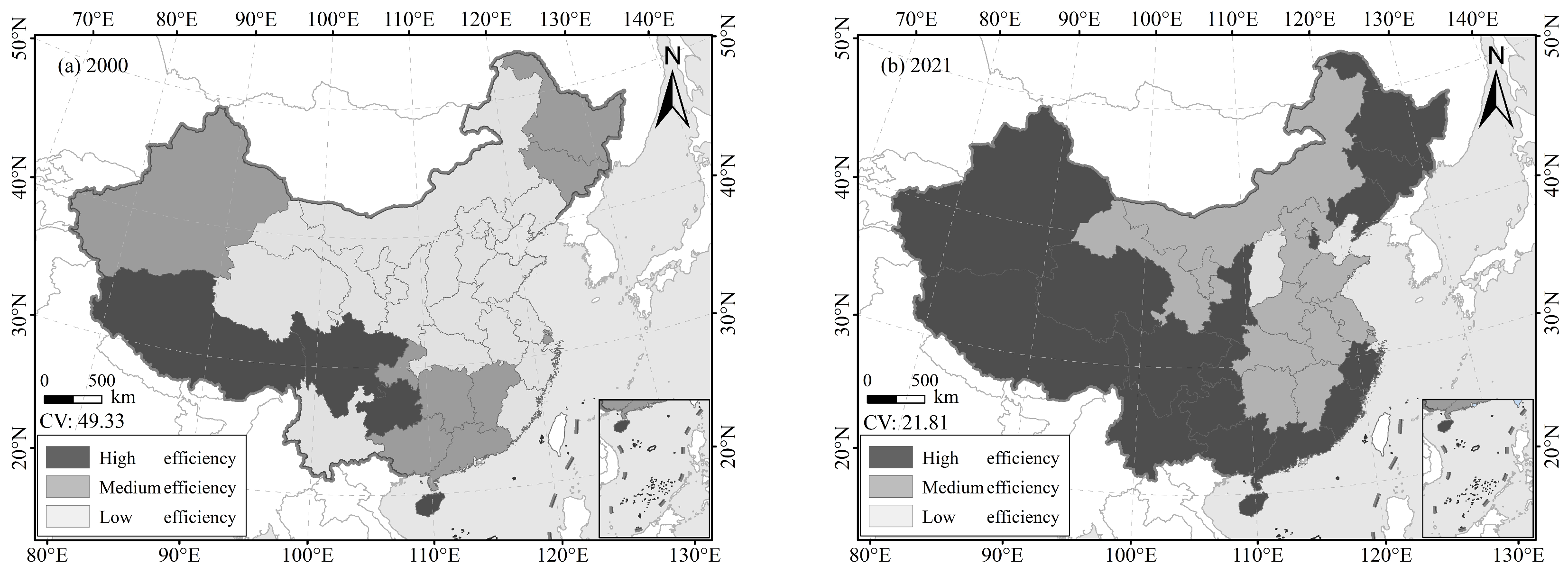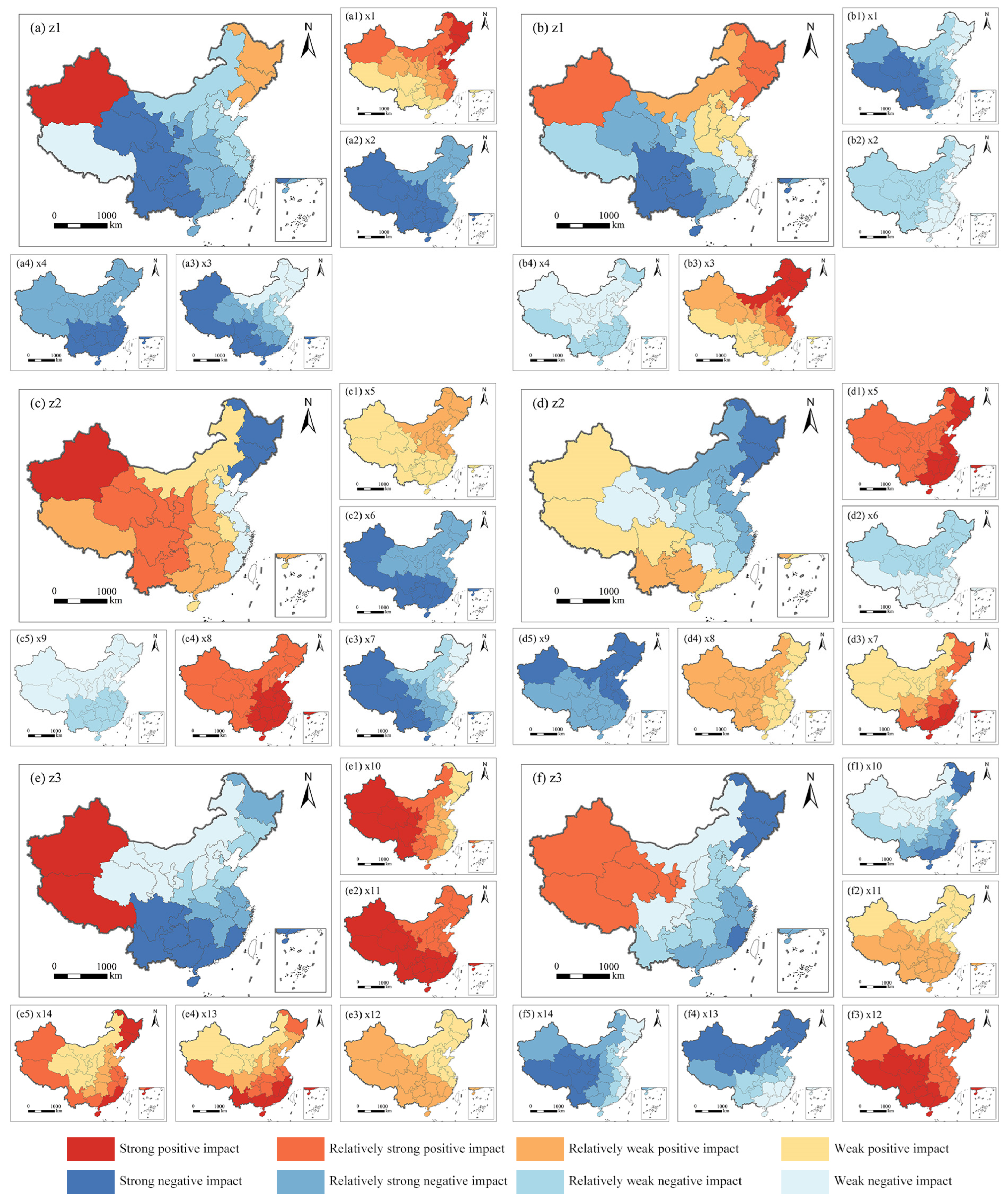Enhancing Agricultural Ecological Efficiency in China: An Evolution and Pathways under the Carbon Neutrality Vision
Abstract
1. Introduction
2. Methods and Data Sources
2.1. Methods
2.1.1. The Window Analysis of Super-SBM-Undesirable Model
2.1.2. GTWR Model
2.1.3. Regional Types of AEE Situation Method
2.2. Data Sources
3. Results
3.1. Characteristic of Input and Output Factors
3.2. Evolution Process of AEE
3.2.1. Spatiotemporal Division of AEE
3.2.2. Spatial Pattern Evolution of AEE
3.3. Driving Factors of AEE
3.4. Evaluation and Classification of the AEE Situation
4. Discussion
4.1. Spatio-Temporal Evolutionary Characteristics of AEE
4.2. Mechanisms and Policy Recommendations of AEE
4.3. Limitations
5. Conclusions
Author Contributions
Funding
Data Availability Statement
Acknowledgments
Conflicts of Interest
References
- Lenton, T.M.; Xu, C.; Abrams, J.F.; Ghadiali, A.; Loriani, S.; Sakschewski, B.; Zimm, C.; Ebi, K.L.; Dunn, R.R.; Svenning, J.-C.; et al. Quantifying the Human Cost of Global Warming. Nat. Sustain. 2023, 6, 1237–1247. [Google Scholar] [CrossRef]
- Schaltegger, S.; Sturm, A. Ökologische rationalität: Ansatzpunkte zur ausgestaltung von ökologieorientierten management instrumenten. Die Unternehm. 1990, 44, 273–290. [Google Scholar]
- Flichmann, G. International Comparisons of Efficiency in Agricultural Production; OECD Publishing: Paris, France, 1990. [Google Scholar] [CrossRef]
- Hou, M.Y.; Yao, S.B. Spatial-temporal evolution and trend prediction of agricultural eco-efficiency in China: 1978–2016. Acta Geogr. Sin. 2018, 73, 2168–2183. [Google Scholar]
- Ke, N.; Lu, X.H.; Kuang, B.; Han, J. Regional differences and influencing factors of green and low-carbon utilization of cultivated land under the carbon neutrality target in China. China Land Sci. 2021, 35, 67–76. [Google Scholar]
- Moutinho, V.; Madaleno, M.; Macedo, P.; Robaina, M.; Marques, C. Efficiency in the European agricultural sector: Environment and resources. Environ. Sci. Pollut. Res. 2018, 25, 17927–17941. [Google Scholar] [CrossRef] [PubMed]
- Grovermann, C.; Wossen, T.; Muller, A.; Nichterlein, K. Eco-Efficiency and Agricultural Innovation Systems in Developing Countries: Evidence from Macro-Level Analysis. PLoS ONE 2019, 14, e0214115. [Google Scholar] [CrossRef] [PubMed]
- Liu, Y.; Zou, L.; Wang, Y. Spatial-Temporal Characteristics and Influencing Factors of Agricultural Eco-Efficiency in China in Recent 40 Years. Land Use Policy 2020, 97, 104794. [Google Scholar] [CrossRef]
- Liu, M.B.; Zhang, A.L.; Wen, G.H. Regional differences and spatial convergence in the ecological efficiency of cultivated land use in the main grain producing Areas in the Yangtze Region. J. Nat. Resour. 2022, 37, 477–493. [Google Scholar] [CrossRef]
- Zhang, H.; Liao, X.P.; Li, C.H.; Yang, C.; Yang, S.S.; Li, Y.H. Spatio-temporal characteristics of agricultural eco-efficiency and its determinants in Hunan Province. Econ. Geogr. 2022, 42, 181–189. [Google Scholar]
- Schulte, H.D.; Armbrecht, L.; Bürger, R.; Gauly, M.; Musshoff, O.; Hüttel, S. Let the Cows Graze: An Empirical Investigation on the Trade-off between Efficiency and Farm Animal Welfare in Milk Production. Land Use Policy 2018, 79, 375–385. [Google Scholar] [CrossRef]
- Mouron, P.; Scholz, R.W.; Nemecek, T.; Weber, O. Life Cycle Management on Swiss Fruit Farms: Relating Environmental and Income Indicators for Apple-Growing. Ecol. Econ. 2006, 58, 561–578. [Google Scholar] [CrossRef]
- Wissmann, M.A.; Hein, A.F.; Neuls, H. Waste generation: An analysis of eco-efficiency in production lines in a dairy industry and its influence on environmental costs. Cust. Agron. 2013, 9, 83–103. [Google Scholar]
- Gaudino, S.; Goia, I.; Grignani, C.; Monaco, S.; Sacco, D. Assessing Agro-Environmental Performance of Dairy Farms in Northwest Italy Based on Aggregated Results from Indicators. J. Environ. Manag. 2014, 140, 120–134. [Google Scholar] [CrossRef]
- Domagała, J. Economic and Environmental Aspects of Agriculture in the EU Countries. Energies 2021, 14, 7826. [Google Scholar] [CrossRef]
- Soteriades, A.D.; Faverdin, P.; Moreau, S.; Charroin, T.; Blanchard, M.; Stott, A.W. An Approach to Holistically Assess (Dairy) Farm Eco-Efficiency by Combining Life Cycle Analysis with Data Envelopment Analysis Models and Methodologies. Animal 2016, 10, 1899–1910. [Google Scholar] [CrossRef] [PubMed]
- Beltrán-Esteve, M.; Reig-Martínez, E.; Estruch-Guitart, V. Assessing Eco-Efficiency: A Metafrontier Directional Distance Function Approach Using Life Cycle Analysis. Environ. Impact Assess. Rev. 2017, 63, 116–127. [Google Scholar] [CrossRef]
- Gémar, G.; Gómez, T.; Molinos-Senante, M.; Caballero, R.; Sala-Garrido, R. Assessing Changes in Eco-Productivity of Wastewater Treatment Plants: The Role of Costs, Pollutant Removal Efficiency, and Greenhouse Gas Emissions. Environ. Impact Assess. Rev. 2018, 69, 24–31. [Google Scholar] [CrossRef]
- Vázquez-Rowe, I.; Villanueva-Rey, P.; Iribarren, D.; Teresa Moreira, M.; Feijoo, G. Joint Life Cycle Assessment and Data Envelopment Analysis of Grape Production for Vinification in the Rías Baixas Appellation (NW Spain). J. Clean. Prod. 2012, 27, 92–102. [Google Scholar] [CrossRef]
- Zou, L.L.; Liu, Y.S.; Wang, Y.S. Shadow prices and pollution costs of agricultural pollutants in China from 1978 to 2017. Trans. Chin. Soc. Agric. Eng. 2020, 36, 223–230. [Google Scholar]
- IPCC. 2006 IPCC Guidelines for National Greenhouse Gas Inventories; Institute for Global Environmental Strategies: Hayama, Japan, 2006. [Google Scholar]
- Crippa, M.; Solazzo, E.; Guizzardi, D.; Monforti-Ferrario, F.; Tubiello, F.N.; Leip, A. Food Systems Are Responsible for a Third of Global Anthropogenic GHG Emissions. Nat. Food 2021, 2, 198–209. [Google Scholar] [CrossRef] [PubMed]
- Zhi, J.; Gao, J.J. Analysis of carbon emission caused by food consumption in urban and rural inhabitants in China. Prog. Geog. 2009, 28, 429–434. [Google Scholar]
- Min, J.S.; Hu, H. Measurement of greenhouse gas emissions from agricultural production in China. China Popul. Resour. Environ. 2012, 22, 21–27. [Google Scholar]
- Qi, Y.C.; Dong, Y.S. Nitrous oxide emissions from soil and some influence factors. Acta Geogr. Sin. 1999, 6, 534–542. [Google Scholar]
- Dong, H.M.; Li, Y.E.; Tao, X.P.; Peng, X.P.; Li, N.; Zhu, Z.P. China’s agricultural greenhouse gas emissions and emission reduction technology countermeasures. Trans. Chin. Soc. Agric. Eng. 2008, 24, 269–273. [Google Scholar]
- Terrer, C.; Phillips, R.P.; Hungate, B.A.; Rosende, J.; Pett-Ridge, J.; Craig, M.E.; van Groenigen, K.J.; Keenan, T.F.; Sulman, B.N.; Stocker, B.D.; et al. A Trade-off between Plant and Soil Carbon Storage under Elevated CO2. Nature 2021, 591, 599–603. [Google Scholar] [CrossRef] [PubMed]
- Jin, S.Q.; Lin, Y.; Niu, K.Y. Driving green transformation of agriculture with low carbon: Characteristics of agricultural carbon emissions and its emission reduction path in China. Reform 2021, 5, 29–37. [Google Scholar]
- Liu, Y.F. A study on carbon cycle in the agroecological system of China. J. Nat. Resour. 1995, 10, 1–8. [Google Scholar]
- Xie, S.J.; Kuang, Y.Q.; Huang, N.S. Main paths and policy proposals for the development of carbon-sinking agriculture in China. China Popul. Resour. Environ. 2010, 20, 46–51. [Google Scholar]
- Tian, Y.; Zhang, J.B. Regional differentiation research on net carbon effect of agricultural production in China. J. Nat. Resour. 2013, 28, 1298–1309. [Google Scholar]
- Liu, Y.S.; Zhai, R.X. Spatial-temporal pattern changes and optimal strategy of grain production in China since 1990s. Areal Res. Dev. 2009, 28, 1–5, 16. [Google Scholar]
- Liu, Y.S.; Wu, C.J. Theories and progress of study on sustainable agriculture development. Econ. Geogr. 2000, 20, 63–68. [Google Scholar]
- Tone, K. A Slacks-Based Measure of Efficiency in Data Envelopment Analysis. Eur. J. Oper. Res. 2001, 130, 498–509. [Google Scholar] [CrossRef]
- Tone, K. A Slacks-Based Measure of Super-Efficiency in Data Envelopment Analysis. Eur. J. Oper. Res. 2002, 143, 32–41. [Google Scholar] [CrossRef]
- Sheng, K.R.; Li, X.R.; Sun, W.; Wang, C.Y. Examining the impacts of network position on urban carbon emissions efficiency in China. Acta Geogr. Sin. 2023, 78, 2864–2882. [Google Scholar]
- Tian, Y.; Zhang, J.B.; Wu, X.R.; Cheng, L.L. Research on dynamic change and regional differences of China’s planting industry carbon sequestration surplus. J. Nat. Resour. 2015, 30, 1885–1895. [Google Scholar]
- Wang, B.Y.; Zhang, W.G. A research of agricultural eco- efficiency measure in China and space- time differences. China Population Resour. Environ. 2016, 26, 11–19. [Google Scholar]
- Rey, S.J. Spatial empirics for economic growth and convergence. Geogr. Anal. 2001, 33, 195–214. [Google Scholar] [CrossRef]
- Huang, B.; Wu, B.; Barry, M. Geographically and temporally weighted regression for modeling spatio-temporal variation in house prices. Int. J. Geogr. Inf. Sci. 2010, 24, 383–401. [Google Scholar] [CrossRef]
- Liu, Y.S.; Zhang, Z.W.; Wang, J.Y. Regional differentiation and comprehensive regionalization scheme of modern agriculture in China. Acta Geogr. Sin. 2018, 73, 203–218. [Google Scholar]
- Yu, G.R.; Wang, Y.S.; Yang, M.M. Discussion on the ecological theory and assessment methods of ecosystem quality and its evolution. Chin. J. Appl. Ecol. 2022, 33, 865–877. [Google Scholar]
- Feng, Z.; Zhang, D.; Yang, Y.Z. Relief degree of land surface in China at county level based on GIS and its correlation between population density and economic development. J. Jilin Univ. Soc. Sci. 2011, 51, 146–151,160. [Google Scholar]
- Zhang, J.; Liu, X.N.; Tan, Z.H.; Chen, Q.G. Mapping of the north-south demarcation zone in China based on GIS. J. Lanzhou Univ. Nat. Sci. 2012, 48, 28–33. [Google Scholar]
- Huang, X.J.; Zhang, X.Y.; Lu, X.H.; Wang, P.Y.; Qin, J.Y.; Jiang, J.C.; Liu, Z.M.; Wang, Z.; Zhu, A.X. Land development and utilization for carbon neutralization. J. Nat. Resour. 2021, 36, 2995–3006. [Google Scholar] [CrossRef]
- Hou, M.Y.; Yao, S.B. Convergence and differentiation characteristics on agro-ecological efficiency in China from a spatial perspective. China Popul. Resour. Environ. 2019, 29, 116–126. [Google Scholar]
- Hu, C.P.; Li, H.S. Research on the space-time trajectory and its coupling trend of the gravity center of China’s agricultural economy and its endowment structure in 1978–2015. J. Huazhong Agric. Univ. Soc. Sci. 2019, 2, 91–99+167. [Google Scholar]
- Zhang, Q.; Zhang, G.L.; Zhu, D.L.; Di, Y.Y.; Yang, T.; Liu, R.Q.; Dong, J.W. Spatiotemporal patterns of paddy rice production change in China during 1980–2018. Resour. Sci. 2022, 44, 687–700. [Google Scholar] [CrossRef]
- Wang, Y.S.; Liu, Y.S. Pollution and restructuring strategies of rural ecological environment in China. Prog. Geog. 2018, 37, 710–717. [Google Scholar]
- Zhang, Z.; Wang, P.; Chen, Y.; Song, X.; Wei, X.; Shi, P. Global warming over 1960–2009 did increase heat stress and reduce cold stress in the major rice-planting areas across China. Eur. J. Agron. 2014, 59, 49–56. [Google Scholar] [CrossRef]
- Ribeiro, P.F.; Santos, J.L. Exploring the effects of climate change on farming system choice: A farm-level space-for-time approach. Land 2023, 12, 2113. [Google Scholar] [CrossRef]






| Target Level | Primary Indicator | Secondary Indicator | Indicator Description |
|---|---|---|---|
| Inputs | Natural resource elements | Land | Crop cultivation area |
| Water resource | Effective irrigated area | ||
| Human and material resources elements | Labor | Agricultural employees = primary industry employees × (total output value of planting industry/total output value of agriculture, forestry, animal husbandry, and fishery) | |
| Fertilizer | Fertilizer application quantity | ||
| Pesticide | Pesticide usage quantity | ||
| Agricultural film | Agricultural film mulch usage quantity | ||
| Agricultural mechanization level | Total power of agricultural machinery | ||
| Diesel | Agricultural diesel consumption | ||
| Desirable outputs | Economic benefits | Total agricultural production value | Construct a base year in 2000 for equal reduction treatment to eliminate the impact of price factors. |
| Ecological benefits | Total agricultural carbon sequestration | C is the total agricultural carbon sequestration; Ci is the carbon uptake of the crop; n is the crop species; ci is the amount of carbon absorbed in the process of photosynthesis synthesizing a unit of organic matter in the crop; Yi is the economic yield of the crop; u is the moisture coefficient of the crop; and HIi is the economic coefficient of the crop [37]. Crops include rice, wheat, maize, beans, yams, peanuts, canola, sunflower, sugarcane, sugar beet, vegetables, tobacco, cotton, melons, and other cereals. | |
| Undesirable output | Greenhouse gas emissions | Carbon emissions from material inputs, CH4 emissions from paddy fields, N2O emissions from soil | , where E is the total amount of agricultural greenhouse gas emissions, Ei is the amount of emissions from each aspect, Gi is the amount of each type of carbon source, and wi is the coefficient of each carbon source [24,26]. The calculation of agricultural greenhouse gas emissions is considered from three aspects: carbon emissions from agricultural materials (fertilizers, pesticides, agricultural films, agricultural machinery power, agricultural diesel), soil N2O emissions, and CH4 emissions from paddy fields, including rice, spring wheat, winter wheat, soybean, corn, vegetables, and cotton [24,26]. According to the IPCC Fourth Assessment Report, the equivalence calculation was carried out according to the fact that 1 ton of CH4 and N2O is equivalent to 6.8182 and 81.2727 tons of C [37], and the uniform replacement of C, CH4, and N2O with C. |
| Non-point source pollution emissions | Nitrogen and phosphorus loss from fertilizers, ineffective utilization of pesticides, and agricultural film mulch residue | U is the total amount of agricultural non-point source pollution emissions, Ui is the number of various types of non-point pollution emissions, Ri is the amount of each agricultural material used, and θi is the loss or residual factor [38] |
| Primary Category | Secondary Category | Variable Description | |
|---|---|---|---|
| Agricultural production conditions Z1 | Farmers’ education level | x1 | Farmers’ education level = 1 − percentage of illiterate people aged 15 years or older in rural areas |
| Rural aging rate | x2 | Percentage of rural population over 65 years old | |
| Per capita cultivated land area | x3 | Cultivated land area/total population | |
| Agricultural biodiversity index | x4 | Simpson diversity index | |
| Physical environmental condition Z2 | Topography | x5 | Relative relief |
| Sunshine duration | x6 | Annual sunshine hours | |
| Temperature | x7 | Annual average temperature | |
| Water resources | x8 | Total water resources | |
| Disaster degree | x9 | Crop disaster area/total sown area of crops | |
| Socio-economic environmental conditions Z3 | Regional economic level | x10 | Per capita GDP |
| Contribution to agricultural output | x11 | Gross agricultural production/GDP | |
| Urbanization level | x12 | Urban population/total population | |
| Level of financial support for agriculture | x13 | Expenditure on agricultural, forestry, and water affairs from the financial budget/general budget expenditure of the local government | |
| Emphasis on regional ecological protection | x14 | Area of ecological protection zones/jurisdiction area |
| Undesirable Outputs | ||||
|---|---|---|---|---|
| High Pollution (−3 Score) | Moderate Pollution (−2 Score) | Low Pollution (−1 Score) | ||
| AEE | High efficiency (3 score) | EPBZ | AEPZ | AEPZ |
| Moderate efficiency (2 score) | APPZ | EPBZ | AEPZ | |
| Low efficiency (1 score) | APPZ | APPZ | EPBZ | |
| Year | Direction | North–South Velocity (km/a) | East–West Velocity (km/a) | Elliptic Area Difference (104 km2) | Elliptic Oblateness Difference (km) | Ellipse Azimuth Difference (Degrees) |
|---|---|---|---|---|---|---|
| 2000–2005 | Northeast | 42.55 | 33.10 | −7.39 | 63.80 | −12.65 |
| 2005–2010 | Northeast | 12.99 | 18.56 | 31.72 | −4.51 | 3.81 |
| 2010–2015 | Northeast | 18.34 | 12.73 | 1.28 | 16.00 | −4.69 |
| 2015–2021 | Southwest | −21.38 | −18.52 | −84.98 | −66.86 | −2.52 |
| 2000–2021 | Northeast | 0.55 | 11.48 | −59.39 | 8.42 | −16.06 |
| Type | Characteristics | Regions | Number of Provinces |
|---|---|---|---|
| AEPZ | High efficiency—low pollution | Chongqing, Tianjin, Zhejiang, Fujian, Hainan, Qinghai, Tibet | 7 |
| High efficiency—moderate pollution | Liaoning, Guizhou, Shaanxi, Guangxi, Guangdong, Jilin, Yunnan | 7 | |
| Moderate efficiency—low pollution | Beijing, Shanghai, Ningxia | 3 | |
| EPBZ | High efficiency—high pollution | Xinjiang, Heilongjiang, Sichuan | 3 |
| Moderate efficiency—moderate pollution | Jiangxi, Hubei, Anhui, Gansu, Hunan | 4 | |
| Low efficiency—low pollution | Shanxi | 1 | |
| APPZ | Moderate efficiency—high pollution | Henan, Shandong, Inner Mongolia, Hebei, Jiangsu | 5 |
Disclaimer/Publisher’s Note: The statements, opinions and data contained in all publications are solely those of the individual author(s) and contributor(s) and not of MDPI and/or the editor(s). MDPI and/or the editor(s) disclaim responsibility for any injury to people or property resulting from any ideas, methods, instructions or products referred to in the content. |
© 2024 by the authors. Licensee MDPI, Basel, Switzerland. This article is an open access article distributed under the terms and conditions of the Creative Commons Attribution (CC BY) license (https://creativecommons.org/licenses/by/4.0/).
Share and Cite
Wang, X.; Liu, Y. Enhancing Agricultural Ecological Efficiency in China: An Evolution and Pathways under the Carbon Neutrality Vision. Land 2024, 13, 187. https://doi.org/10.3390/land13020187
Wang X, Liu Y. Enhancing Agricultural Ecological Efficiency in China: An Evolution and Pathways under the Carbon Neutrality Vision. Land. 2024; 13(2):187. https://doi.org/10.3390/land13020187
Chicago/Turabian StyleWang, Xiaochen, and Yaqun Liu. 2024. "Enhancing Agricultural Ecological Efficiency in China: An Evolution and Pathways under the Carbon Neutrality Vision" Land 13, no. 2: 187. https://doi.org/10.3390/land13020187
APA StyleWang, X., & Liu, Y. (2024). Enhancing Agricultural Ecological Efficiency in China: An Evolution and Pathways under the Carbon Neutrality Vision. Land, 13(2), 187. https://doi.org/10.3390/land13020187







